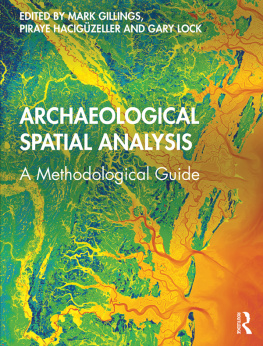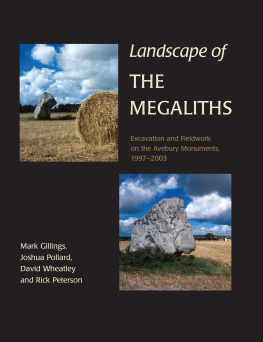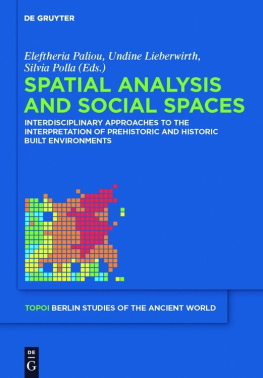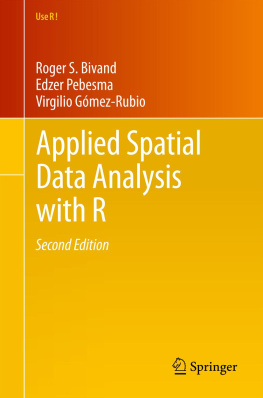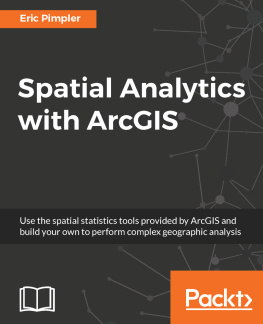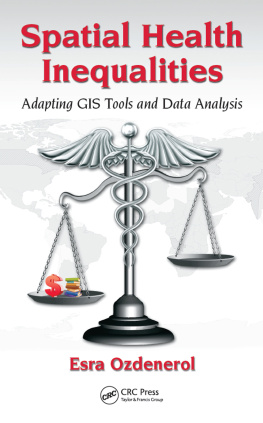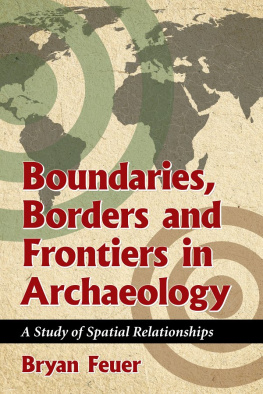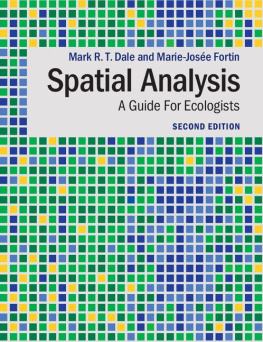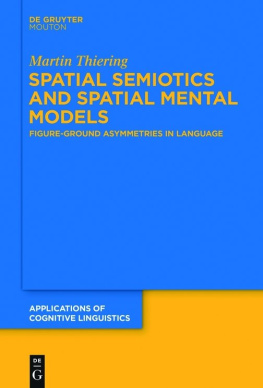Mark Gillings - Archaeological Spatial Analysis
Here you can read online Mark Gillings - Archaeological Spatial Analysis full text of the book (entire story) in english for free. Download pdf and epub, get meaning, cover and reviews about this ebook. year: 2020, publisher: Taylor & Francis Group, genre: Politics. Description of the work, (preface) as well as reviews are available. Best literature library LitArk.com created for fans of good reading and offers a wide selection of genres:
Romance novel
Science fiction
Adventure
Detective
Science
History
Home and family
Prose
Art
Politics
Computer
Non-fiction
Religion
Business
Children
Humor
Choose a favorite category and find really read worthwhile books. Enjoy immersion in the world of imagination, feel the emotions of the characters or learn something new for yourself, make an fascinating discovery.
- Book:Archaeological Spatial Analysis
- Author:
- Publisher:Taylor & Francis Group
- Genre:
- Year:2020
- Rating:5 / 5
- Favourites:Add to favourites
- Your mark:
- 100
- 1
- 2
- 3
- 4
- 5
Archaeological Spatial Analysis: summary, description and annotation
We offer to read an annotation, description, summary or preface (depends on what the author of the book "Archaeological Spatial Analysis" wrote himself). If you haven't found the necessary information about the book — write in the comments, we will try to find it.
Mark Gillings: author's other books
Who wrote Archaeological Spatial Analysis? Find out the surname, the name of the author of the book and a list of all author's works by series.
Archaeological Spatial Analysis — read online for free the complete book (whole text) full work
Below is the text of the book, divided by pages. System saving the place of the last page read, allows you to conveniently read the book "Archaeological Spatial Analysis" online for free, without having to search again every time where you left off. Put a bookmark, and you can go to the page where you finished reading at any time.
Font size:
Interval:
Bookmark:
ARCHAEOLOGY AND SPATIAL ANALYSIS
Mark Gillings, Piraye Hacgzeller and Gary Lock
This book comprises twenty-three detailed chapters describing key spatial analytical techniques and their application to archaeology. As the title of the book suggests the focus is on methodology, and the chapters herein cover a range of techniques, both established and emerging. Although the emphasis is on practice the how to do it it is crucial to stress from the very start that underlying any application of these techniques must be the why we do it. Each chapter in the volume offers an introduction covering the background of that particular technique. Here we present some thoughts on the development of spatial archaeology more generally and why we think it is fundamental to much of what we do as practicing archaeologists.
We start by considering the centrality of space to everyday life and archaeology as a discipline, and open up this discussion further by laying out some of the relations that archaeological space finds itself entangled with, such as time, practice and representation. Following this, we offer a brief historical overview of the development of spatial analysis in archaeology. This explores the contribution of the early antiquarians, through the formulation and zenith of formal spatial techniques in the late 1950s to early 1980s, their fall from favour and then second coming in the 1990s due to the introduction of a range of spatial technologies, not least Geographic Information Systems (GIS). This is then followed by a consideration of why concepts of space and spatiality underlie much archaeological thought, what can be called spatial thinking in archaeology, and how this relates to what is understood by spatial analysis. The chapter concludes with a careful consideration of what it means to think spatially in order to foreground the goal of the volume as a whole, which is to make a positive contribution to the on-going development of archaeological spatial literacy at a time of significant theoretical and methodological transformation.
Being human embodies space and spatial relationships within a material world and just as this applied to people living in the past, so it applies to those of us concerned with trying to understand those past lives through their remaining material residues. Most, if not all, archaeological material has a spatial component and it is not surprising, therefore, that spatial thinking and spatial analysis has been a central archaeological endeavour since the beginnings of the discipline. While some other social sciences and humanities disciplines, particularly history, have claimed a fairly recent spatial turn (Bodenhamer, Corrigan, & Harris, 2010; Warf & Arias, 2009), archaeology in all its changing forms has always incorporated an implicit or explicit acceptance that space and spatial relationships are a fundamental part of doing archaeology. It has also been highly proactive in co-opting and developing the methodological tools needed to explore this spatiality, culminating in the rich variety of approaches available to us today; a consequence of developments in theory and practice alongside changing analytical and technological opportunities.
In fact, space, spatiality and spatial awareness are such fundamental parts of being human that we often take them for granted at the bodily level of moving through and experiencing the world. Developments in digital geospatial technology and the increasingly pervasive presence of locational media have increased this familiarity only further (see Wood, 2012, p. 280). It is this very familiarity that risks blinding us to the spatial formations of social life and to how we actively manipulate space and spatial relationships to shape the world around us through the activities, behaviours and structures that give our lives meaning. These spatial manipulations and interventions are what make us distinctive and different to other cultural groups, offering both social cohesion and social exclusion at the same time. This assumption of essential human spatiality is what underlies much traditional spatial archaeology the isolation and interpretation of spatial patterns within archaeological evidence that relate archaeological activity in the present to the generative processes in the past that we are interested in.
But what are some of the complex relations that describe archaeological space and spatialities? Through which relations are we able to do spatial archaeology and interpret human-space interactions in the past? We briefly lay out five of them here. For one, space in archaeology is linked to time (see Taylor, this volume). Prior to the mid-20th century, cultural evolutionary and cultural historical approaches in archaeology explicitly privileged time over space working with long time scales, and grand themes and trends (see Trigger, 1998), echoing a modernist discursive practice (Roberts, 2012, p. 14). Yet, arguably, archaeologists realised relatively early on that notions of space and notions of time were intimately linked and these were often treated as tacit conceptual axes along which analyses and interpretations were structured, often alongside a further axis such as form (Spaulding, 1960) sociality and the social (Soja, 1996) and materials and material relations (Conneller, 2011; Lucas, 2012, pp. 167168).
Secondly, space in archaeology is about mobility, rendering movement across space a key focus of archaeological and anthropological inquiry (e.g. Hammer, 2014; Richards-Rissetto & Landau, 2014; Snead, Erickson, & Darling, 2009; cf. Verhagen, Nuninger, & Groenhuijzen, 2019). Regardless of its context and spatial scale, traversing space affords imaginations about what is to come, reflections on what is left behind and memories of places. As such, it connects time and space with living. After all, human life is a temporal process that unfolds with the formation of places through movement and through the material and immaterial traces that movement leaves behind (Ingold, 1993; see Atkinson & Duffy, 2019; McCormack, 2008). Yet how can a preoccupation with spatial movement and all of the terms that come with it (e.g. flows, networks and liquidity, often used to describe and analyse conditions of late capitalism, and to construct sweeping grand narratives of globalisation) give hope to archaeologists trying to come to terms with specific, tangible materialities of particular times and places (Dalakoglou & Harvey, 2012, p. 459)? It appears that thinking through space with movement is a rather different approach than looking at movement to observe and describe space: while the latter involves an examination of selected outcomes including spatial patterns in order to trace antecedent causes, the first attempts to follow forward moment-to-moment spatial formations intently (see Ingold, 2011, pp. 67; Knappett, 2011).
Thirdly, space in archaeology is about stories and daily practices (such as practices of gathering, composition, alignment and reuse) that typically form spatial assemblages with archaeologically traceable material dimensions (McFarlane, 2011, p. 649; see Seigworth, 2000; Thrift, 2008). The iterative processes of creating these assemblages and relations are in fact processes of place-making, processes of dwelling. They involve assembling relations between humans, non-humans, materials, immaterials, and animate and inanimate things that continually produce the character and history of places (see also McFarlane, 2011). Places come about then through routine repetition that is permeated by the past and the present, and oriented toward the future (Resina & Wulf, 2019, p. vii); they come about through enactment and performance of relations anew almost daily. What about telling and re-telling engaging qualitative and quantitative archaeological stories about these places? They can be considered as just another act of re-performing spatial relations that re-assemble archaeological places in the present.
Font size:
Interval:
Bookmark:
Similar books «Archaeological Spatial Analysis»
Look at similar books to Archaeological Spatial Analysis. We have selected literature similar in name and meaning in the hope of providing readers with more options to find new, interesting, not yet read works.
Discussion, reviews of the book Archaeological Spatial Analysis and just readers' own opinions. Leave your comments, write what you think about the work, its meaning or the main characters. Specify what exactly you liked and what you didn't like, and why you think so.

